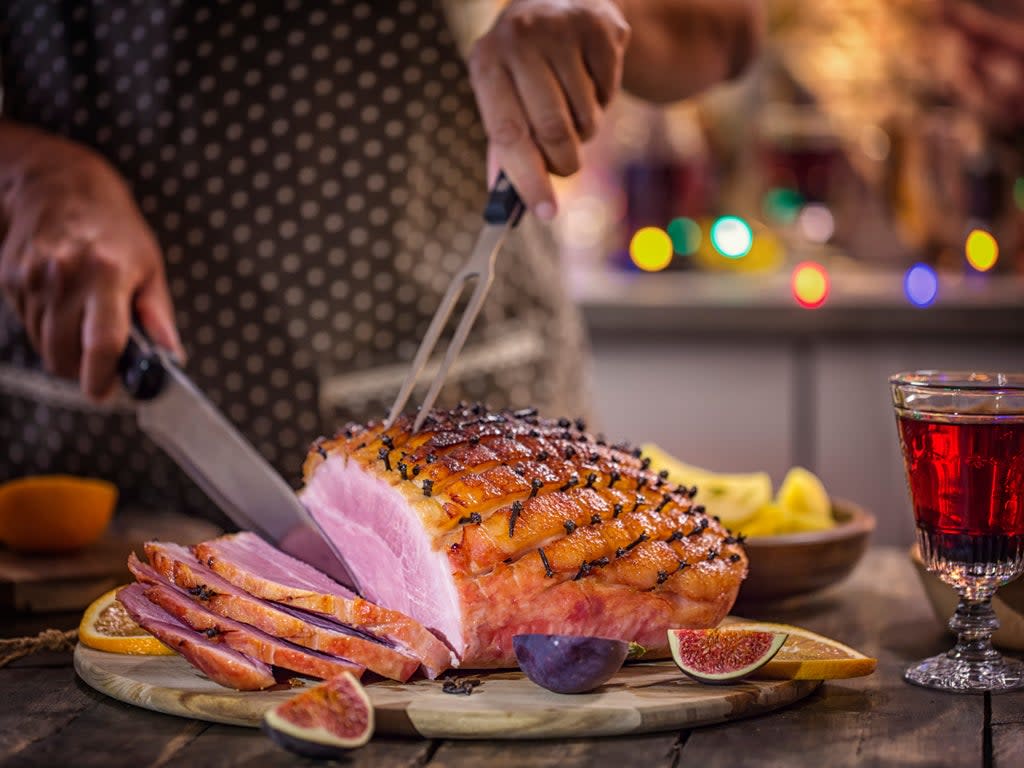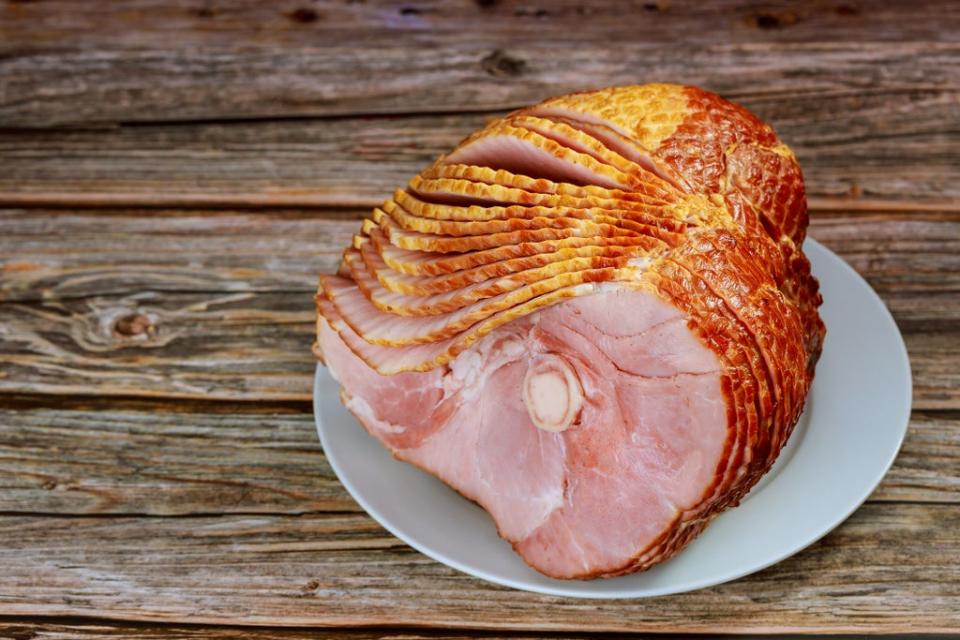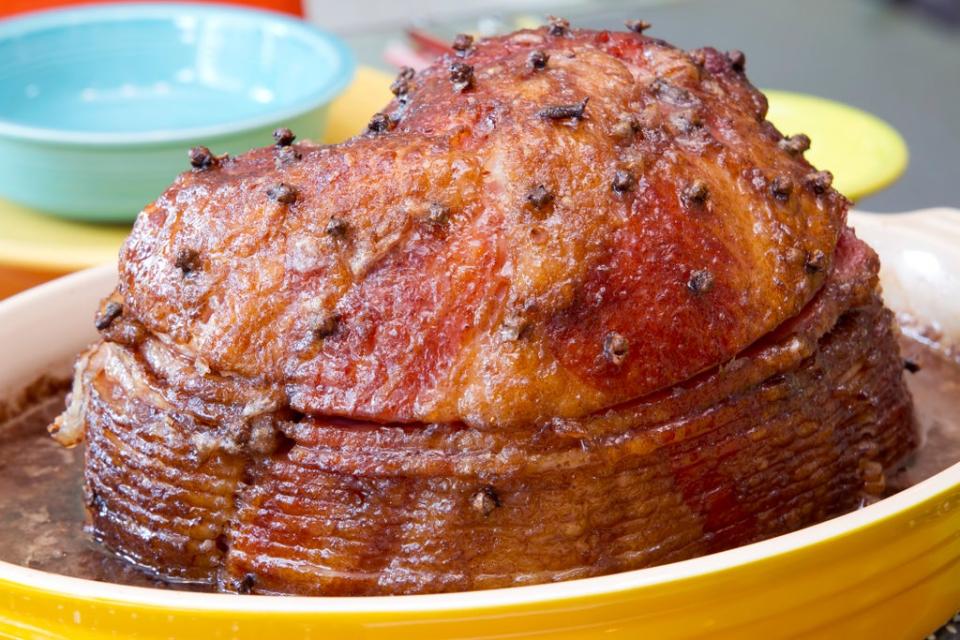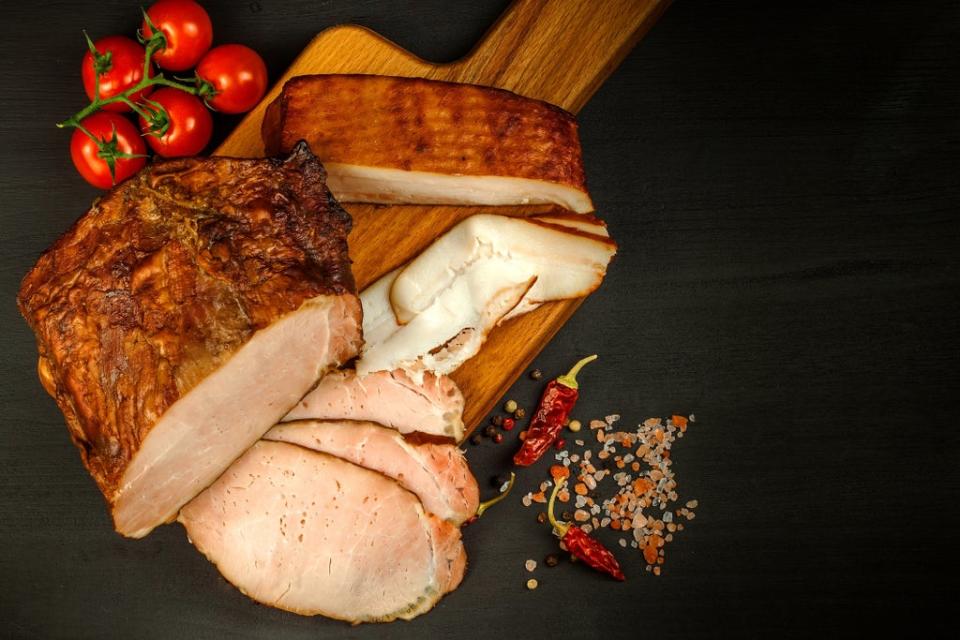The perfect way to cook ham this Easter

A homemade ham represents a formidable culinary challenge.
You might start with a pig’s hind leg, which tips the scale at 15 to 20 pounds. You would cure it in a brine that contains at least one potentially toxic ingredient (more on that in a minute) – a task that requires several weeks and occupies the bottom shelf of your fridge for the duration. Then, the smoking alone can take 24 hours or more.
No wonder most people buy supermarket ham – customarily crusted with brown sugar, porcupined with cloves or shingled with sliced pineapple and maraschino cherries – and reheat it.
But what if there were an easy, relatively quick way to cure and smoke ham at home that yields even better results than the supermarket version?
Read more:
Ham has been called pork’s leap to immortality, a source of sustenance and gustatory happiness for much of human history. People have been perfecting how to make it for millenniums. By the time Roman agronomist Cato the Elder wrote his famous treatise on agriculture around 160 BC, the techniques for salt-curing ham he describes were well established, the precursor of today’s prosciutto and speck.
Today, there are hundreds of types of ham, many with long histories – take, for instance, York ham from England, the venerable Jinhua hams of China and smoked hams from Smithfield, Virginia. The easiest way to keep track of them is to group hams into two basic families: dry-cured and wet-cured.
Dry-cured hams are rubbed with salt and air-dried for several months, resulting in the tight, satiny texture and complex flavour associated with Italian prosciutto and Spanish jamón serrano. It’s a process not easily undertaken at home, and you pay for the lengthy curing time. A single Spanish jamón Ibérico de Bellota, for example, can cost over £700.
Wet-cured hams soak in a brine of water, salt and sodium nitrite (or other curing salt), often with sugar or honey added for sweetness, and bay leaves and peppercorns for spice. Here, the curing process is quicker because you can inject part of the brine into the meat (thus curing it both from the outside-in and inside-out). This is the sort of ham that graces most family dinner tables, with moist, rose-coloured meat and a salty-sweet tang.

The third element for ham-making is wood smoke, originally used as a preservative and flavouring. Both dry-cured and wet-cured hams can be smoked (most, although not all, are) – a process that can stretch days. Smoked hams are especially popular in the US, where smokehouses routinely burn hickory, applewood or even corncobs.
Ham of the smoked, wet-cured variety is surprisingly easy to make at home, but you’ll need time, fridge space and one special ingredient: pink curing salt. Also known as Prague Powder #1 and named for where it was originally developed, it contains 6.25 per cent sodium nitrite, a naturally occurring compound that gives ham (not to mention pastrami, corned beef and bacon) its rosy hue and rich umami flavour. More important, the compound prevents botulism and other bacterial contamination.
In large quantities, sodium nitrite can be toxic, so manufacturers tint the curing salt pink to prevent it from being inadvertently used as a seasoning. Pink curing salt is available online. Do not confuse it with Himalayan pink salt, which is pink-tinged regular sodium chloride and has no anti-botulism properties.
Over the years, sodium nitrite has been embraced and vilified (the vilification was on the basis of a questionable scientific study carried out more than 30 years ago). Numerous studies deeming sodium nitrite safe when used at appropriate levels have since exonerated it. And it turns out that sodium nitrite is also found in many plants, such as rocket and celery. It doesn’t deserve its bad rap.
In terms of equipment, you’ll need a stockpot, bucket or 3-gallon heavy-duty resealable plastic bag for brining and a marinade injector, which looks like an oversized hypodermic needle. You’ll use it to inject the brine deep into the meat, accelerating the curing process and making you feel a little bit like a mad scientist when using it.
Finally, you’ll need a way to smoke your ham: a kettle-style grill or other charcoal-burning grill with a lid does the job nicely. Set up your grill for indirect grilling and heat to 250 degrees, adjusting the top and bottom vents to control the airflow (more airflow raises the heat; less lowers it).
When you cure and smoke your own ham, you control what goes into it. You’ll be joining a long line of ham makers and lovers when you lift the lid of your grill
The other trick to achieving the requisite low smoking temperature is to use less charcoal, preferably natural lump, than you normally would. Add soaked, drained hardwood chips, such as apple or hickory, or unsoaked wood chunks to the coals at regular intervals to obtain a light but steady stream of smoke. Alternatively, smoke your ham in a smoker.
Mindful of the reduced size of many Easter gatherings this year, try curing and smoking a shoulder ham. Cut from the pig’s forequarter (just under the Boston butt), it typically weighs 9 to 10 pounds (half the size of a full hind-leg ham) and can be cured and smoked in a week (don’t worry, most of that time is waiting). A shoulder ham remains a magisterial cut of meat that never fails to impress when presented and carved.
And if a shoulder ham still sounds daunting? You can give the ham treatment to a smaller, quicker-cooking cut, like a pork loin, also used to make back bacon. Think of this as ham in a hurry. In addition to its convenient size and speed of preparation, it’s considerably easier to carve than a bone-in ham.
Supermarket hams often come plumped with liquid to make them heavier and chemical additives to extend their shelf life. A disheartening number owe their “smoke” flavour not to a sojourn in a smokehouse but to a shot of liquid smoke.
When you cure and smoke your own ham, you control what goes into it. You’ll be joining a long line of ham makers and lovers when you lift the lid of your grill to behold your smoke-bronzed porcine masterpiece. There, you’ll also find satisfaction beyond compare.

Honey-cured, hickory-smoked shoulder ham
Makes: 12 starters or 6 to 8 mains
Total time: 7 hours’ smoking, 6 days’ curing, plus prep, cooling and drying time
For the brine:
2 cups kosher salt
1½ cups honey
1 packed cup dark brown sugar
2tbsp Prague Powder #1 (or equivalent)
For the spice bundle:
6 cloves
6 allspice berries
3 fresh or dried bay leaves
3 fresh lemon zest strips
1tbsp whole black peppercorns
For the ham:
1 fresh skin-on, bone-in (9 to 10lbs) shoulder ham (sometimes called picnic ham)
1. Make the brine: in a large pot, place 2½ quarts water, the salt, honey, brown sugar and Prague Powder. Bring to a boil over high, stirring until the salt, honey and sugar are dissolved.
2. Make the spice bundle: tie the cloves, allspice berries, bay leaves, lemon zest and peppercorns in a piece of cheesecloth.
3. Stir the spice bundle and another 2½ quarts ice water into the brine, remove from heat and let the mixture cool to room temperature (about 30 minutes).
4. While the brine cools, prepare the ham: using paper towels, blot the pork shoulder dry on all sides. Using a sharp knife, score the ham in a crosshatch pattern, cutting through the skin but not through the meat, and spacing the cuts 1½ inches apart (this is optional, as you’ll remove the skin, but it facilitates injecting and gives the ham a striking appearance).
5. Measure out 2 cups brine and place in a deep measuring cup. Place the ham in a roasting pan. Draw the brine into a marinade injector and inject it deep into the ham all over, inserting the needle at 1½in intervals and drawing it out slowly as you depress the plunger, until the brine starts to squirt out of the surface of the ham.
Champagne would be great and, if you have embraced sherry, fino is a wonderful match for ham
6. Place the ham in a large pot or food-safe bucket with a lid, or 3-gallon resealable plastic bag. Add the brine and flavourings (plus any brine in the roasting pan). If using a plastic bag, tightly seal, squeezing out any air, and place the bag in the roasting pan to corral any leaks. Brine the ham in the fridge for 3 days, turning the ham twice a day so it cures evenly.
7. Pour the brine into a large pot and set aside. Remove the ham from its pot or bag and transfer it to a roasting pan. Using the marinade injector, re-inject the ham with brine (using 2 cups again, or more, if you can get more in), inserting the needle at 1½in intervals. Return the ham and all the brine to the bag (you can use a fresh bag, if you wish). Continue brining the ham in the fridge for another 3 days, turning twice a day so it brines evenly. When ready for smoking, the meat will take on a pinkish hue.
8. Drain the ham in a large colander, discarding the brine. Rinse the ham well with cold water, drain again and blot dry with paper towels. Place it on a wire rack over a roasting pan and let it dry for 2 to 3 hours in the fridge.
9. If using a charcoal grill, set it up for indirect grilling and heat it to 250 degrees. If using wood chips, soak them in water to cover for 30 minutes, then drain. If using wood chunks, there is no need to soak them (with a kettle grill, use less charcoal than normal to obtain this low temperature). If using a smoker, heat it to 250 degrees following the manufacturer’s instructions.
10. Place the ham on the grate, fat-side up, using indirect heat, and add 1½ cups wood chips or 2 wood chunks to the coals. Smoke the ham until handsomely browned and cooked through (the internal temperature will be about 160 degrees). This typically takes about 7 hours, but you may need more or less time, depending on your ham, smoker and the weather. Add wood chips (about 1½ cups) or chunks (1 large or 2 medium) per hour to the embers to maintain a constant flow of smoke. Rotate your ham a few times during cooking so that it browns evenly, and drape it loosely with foil if it seems to be darkening too much.
11. Transfer the ham to a cutting board and let it cool for 20 minutes. Pull off the skin (if you’re feeling ambitious, you can fry the skin in 350-degree oil to make smoke-flavoured cracklings).
12. Thinly slice the ham across the grain and serve. You can serve the ham hot, at room temperature or chilled. Refrigerated, it will keep for at least a week.

Ham-cured, smoked pork with cognac-orange glaze
Makes: 6 servings
Total time: 4 hours, plus 48 hours’ brining
For the brined pork:
â packed cup dark brown sugar
½ cup kosher salt
2tsp Prague Powder #1 (or equivalent)
2 fresh or dried bay leaves
2 fresh orange zest strips
2 cloves
1 (3lbs) boneless pork loin
For the glaze:
2 cups freshly squeezed orange juice
½ cup cognac
½ packed cup dark brown sugar
¼cup orange marmalade
1 cinnamon stick
¼tsp ground cloves
1tsp cornstarch
1tbsp Cointreau, Grand Marnier or other orange liqueur
3tbsp unsalted butter, cut into ½in chunks
Sea salt and black pepper
1. Make the brine: bring 1 quart of water to a boil in a large saucepan over high heat. Add the sugar, salt and Prague Powder. Whisk until dissolved and remove from heat. Stir in 1 quart cold water. Pin the bay leaves to the orange zest strips using the cloves, and add them to the brine. Let the mixture cool to room temperature, about 1½ hours.
2. Wash the pork loin and blot dry. Place it in a baking dish just large enough to hold it.
3. Measure out ½ cup brine into a measuring cup. Draw the brine into a marinade injector and inject it into the centre of the pork loin all over, inserting the needle at 1in intervals and drawing it out slowly as you depress the plunger, until you’ve used the full ½ cup brine and the brine starts to squirt out of the pork.
4. Transfer the pork to a large, heavy-duty resealable plastic bag. Add the brine from the baking dish, plus the remaining brine and seasonings, and tightly seal, squeezing out any air. Return the bagged pork to the baking dish to corral any leaks. Brine the pork in the refrigerator for 24 hours, turning several times along the way so it brines evenly.
The wine you choose to drink with ham depends on what sort of ham you are serving and how it is flavoured, and particularly whether it is glazed
5. Remove the loin from the brine and place it in another baking dish, reserving the brine. Re-inject the pork loin with the brine in the bag, again using about ½ cup (or more if you can get more in), then return the pork to the brine bag and continue brining and turning for another 24 hours, for a total brining time of 48 hours. The meat should turn a shade pinker. At this point, you can dry and smoke the pork loin, but if you brine it for another 24 hours, the flavour will be even richer.
6. Drain the brined pork loin in a colander, discarding the brine. Rinse the loin well with cold water, drain again and blot dry with paper towels. Place it on a wire rack over a baking dish and let it dry for 1 hour in the fridge.
7. Meanwhile, set up your grill for indirect grilling and heat to medium (about 350 degrees). If using wood chips, soak about 3 cups chips in water to cover for 30 minutes, then drain. If using wood chunks, there is no need to soak them.
8. Place the pork loin on the grate, fat-side up, over indirect heat, set over a drip pan. Add 1½ cups wood chips or 2 wood chunks to the coals.
9. Smoke the pork loin until handsomely browned and cooked through (the internal temperature will be about 155 degrees), about 1½ hours. Add wood chips (about 1½ cups) or chunks (1 large or 2 medium) per hour to the embers to maintain a constant flow of smoke.
10. While the pork cooks, make the glaze: place the orange juice, cognac, brown sugar, marmalade, cinnamon and cloves in a nonreactive saucepan. Boil over high heat until syrupy and reduced by half, 10 to 15 minutes.
11. In a small bowl, whisk together the cornstarch and Cointreau, then carefully whisk the slurry into the glaze. Boil for 1 minute. The glaze will thicken. Whisk in the butter, and season with salt and pepper to taste (makes about 1¼ cups).
12. Brush the glaze on the pork three times during the last 20 minutes of cooking. Reserve the remaining glaze.
13. When the pork is done, transfer to a platter and let rest for 5 minutes. To serve, thinly slice the pork loin across the grain and serve with the remaining glaze on the side.
Read More:
And to drink...
The wine you choose to drink with ham depends on what sort of ham you are serving and how it is flavoured, and particularly whether it is glazed. With a fruity glaze, I would look for a fresh red with some fruit, maybe a cru Beaujolais, a softer Burgundy like a Savigny-lès-Beaune or Chorey-lès-Beaune, or, if you can find one, a Sancerre Rouge, which is made of pinot noir, or a pinot noir from Oregon, Germany or New Zealand. You could also drink a moderately sweet riesling, like a German spätlese or a well-aged auslese, which would be a rare treat. With a ham that’s more smoky and savoury, with distinct umami flavours, a dry riesling from Germany or Alsace would be nice. Champagne would be great and, if you have embraced sherry, fino is a wonderful match for ham.
© New York Times

